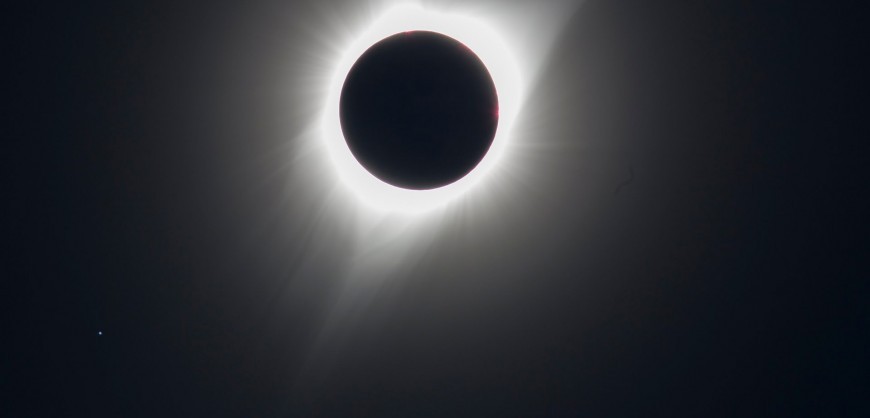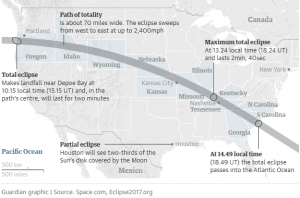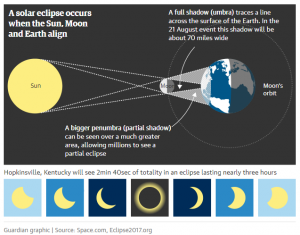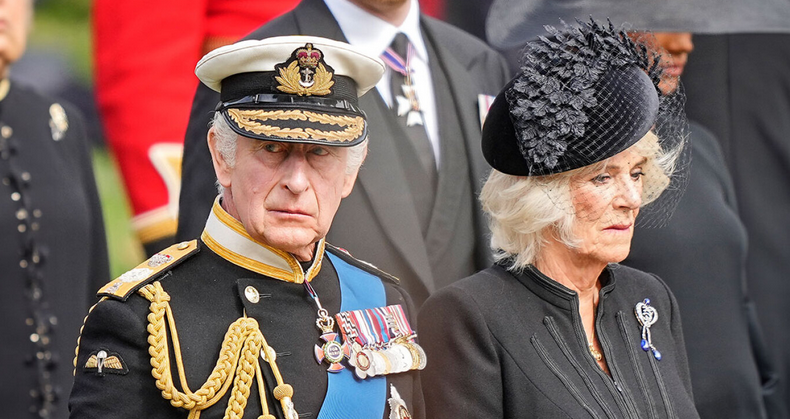The moon blocked out the sun on Monday as the first coast-to-coast total solar eclipse in the US in nearly a century began over the west coast, while millions of Americans looked skyward in wonder through protective glasses, telescopes and cameras.
After weeks of anticipation, the sight of the moon’s silhouette passing directly in front of the sun, blotting out all but a halo-like solar corona and causing a precipitous drop in temperature, drew whoops and cheers from onlookers gathered in Madras, Oregon.
“First contact!” someone yelled. Horns honked. Eclipse glasses were popped on to faces, all of which turned eastward to the sun.
As the sky grew dark, around 10.16am, the temperature started to drop and eclipse viewers started to shout and cheer. The most common exclamation was: “Oh my God!” A ring of light glimmered around the black moon – the long-awaited corona, finally safe to view with the naked eye.
Light returned quickly. “Come back, moon!” someone yelled. As onlookers exhaled and shook the tension out of their bodies, someone said: “I could have looked at that for another 20 minutes!”
As quickly as it came, the eclipse receded, as the umbra – the location of the total shadow – bolted across the continent at an average speed of 1,700 miles per hour. When all is said and done the “totality” will have engulfed a strip of the country occupied by 12.2 million people, joined temporarily by millions more who traveled to the 70-mile-wide eclipse path for the spectacle.
In Madras, Keeman Wong had been waiting 15 years for the moment. He first bought a solar filter as a middle schooler in Hong Kong in the 1960s, to protect his eyes during a partial eclipse. For the past 15 years, Wong, who now lives in Los Angeles, has attempted to witness a total solar eclipse – in Zimbabwe, Easter Island and China – but each attempt was foiled by weather, travel snags or state department warnings against travel to dangerous areas. He was entranced by how eclipse viewers spoke about their experiences.
“They describe it as life-changing,” he said.
This time, he let nothing get in his way. He even packed the small rectangular filter that he’d bought five decades ago.
“I got here early because I said, ‘if there’s an accident on the road, an earthquake… I’m going to be there’,” he said. “It’s worth everything.”
For Wong, the most spectacular moment was the end of the total eclipse. “I’m not religious but I think it’s something very like when God says, ‘let there be light’,” he said.
It was the first total solar eclipse visible from the mainland US in more than 38 years, and the last for another seven years when the next eclipse will cut the opposite diagonal from Texas, through the midwest and up through New York and New England.
Viewers in the narrow totality band were treated to as much as two minutes, forty seconds of utter nighttime in the middle of the day and the otherwise unimaginable spectre of a 360-degree sunset. Those in the path of the totality were able to see the normally invisible solar corona, which appeared as an enormous pale white crown spreading outward from the obscured shadow of the sun.
The Corona of the Sun in Jefferson Park, Oregon at 10:21 PDT. #SolarEclipse2017 pic.twitter.com/KtEHAaQfsD
— Dave Bernhardt (@AstrobiologyGuy) August 21, 2017
Those out of the direct path of the eclipse got a show too, if a far less dramatic one. In all but the tiniest corner of Maine, people in the US were able to see at least 50% of the sun’s face covered up by the passing moon. Nationwide, people also got to experience the ancillary effects of a total eclipse as well, including odd animal behavior and a pronounced temperature drop of anywhere from 3-12F.
I think the coolest part of that was experiencing the noticeable temperature drop. Wow. Super thankful I happened to live in this path
— Amanda Lee Carraway (@amanduh42) August 21, 2017
Nasa invited casual observers to track temperature and cloud data on their phone to build an open-source map of the eclipse, the first US total eclipse of the smartphone era.
Hoping to learn more about the sun’s composition and activity, Nasa and other scientists watched and analyzed from telescopes on the ground and in orbit, the International Space Station, airplanes and scores of high-altitude balloons beaming back live video.
Citizen scientists also planned to monitor animal and plant behavior as daylight turned into twilight and the temperature dropped. Thousands of people streamed into the zoo in Nashville, Tennessee just to watch the animals’ reaction.



































